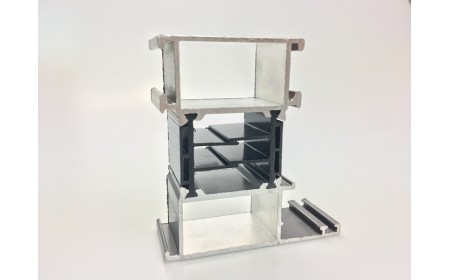THERMALLY BROKEN WINDOWS AND DOORS
This construction method utilises single or multiple cavities to create insulated air spaces and a space frame construction that is common in building structural members. The polyamide strips are good thermal insulators and block the transfer of energy (hot or cold) in the frame.
By increasing the width of the polyamide strips the amount of energy transferred by conduction is reduced significantly improving thermal performance.
THERMALLY BROKEN WINDOWS AND DOORS
Windows and doors generally account for approximately one third of the exterior wall area of your home.
Today we are very conscious of energy loss and attempting to keep our homes at a comfortable year round temperature, warm in winter and cool in summer. New homes and alterations that are required to comply with the New Zealand Building Code must meet a minimum R value which is a measure of their thermal efficiency. To help facilitate this; ceilings, floors and walls are insulated and windows are double glazed. An often overlooked area of potential heat loss (or gain) is the actual window or door frame itself.
In NZ though 9 out of 10 homes use aluminium window and door frames. There are many reasons for this such as; low maintenance, wide colour choice, long life, dimensional stability, strength, security and price competiveness.
Aluminium however is a highly conductive material and subsequently a very poor insulator. This property of aluminium means the window or door frame itself can be responsible for energy loss.
Insulated Frame Types:
This energy loss may be reduced by specifying Thermally Broken or insulated aluminium frames. This is achieved by using either polyamide insulating thermal strips or an insulating polymer. The thermal break works in association with double (or even triple) glazing by providing an insulating barrier within the frame minimising the transfer of energy (heat or cold) via the frame.
1. Polyamide Insulating Thermal Strips
Thermally Broken aluminium frames, at the time of manufacture, have two polyamide strips inserted and mechanically fixed by roll forming between the inside and outside faces of the window extrusions.
This construction method utilises single or multiple cavities to create insulated air spaces and a space frame construction that is common in building structural members. The polyamide strips are good thermal insulators and block the transfer of energy (hot or cold) in the frame.
By increasing the width of the polyamide strips the amount of energy transferred by conduction is reduced significantly improving thermal performance.
2. Polyurethane Insulating Polymer
Thermally Broken aluminium frames, at the time of manufacture, have a section of the aluminium frame replaced with a polyurethane insulating polymer. The polymer is poured into a channel between the inside and outside faces of the window extrusions. When the polymer has set hard, the aluminium that formed the channel is removed leaving only the insulating polymer, which is a good thermal insulator that blocks the transfer of energy (hot or cold) in the frame.
By increasing the width of the polyurethane insulating polymer and the piece of aluminium that is machined away, the amount of energy transferred by conduction is reduced significantly improving thermal performance.
Thermally broken windows can contribute to a more comfortable and healthy living environment in your home.
(The article sourced from http://www.wanz.co.nz/thermally-broken-window-frames .
)

